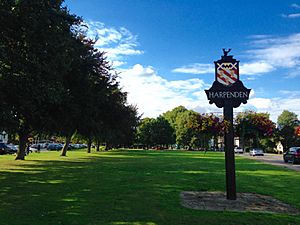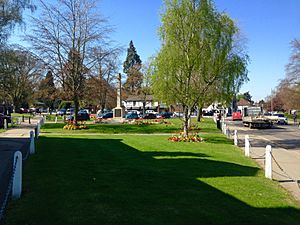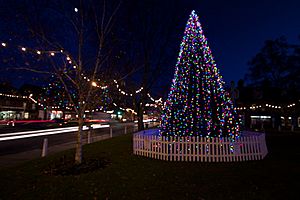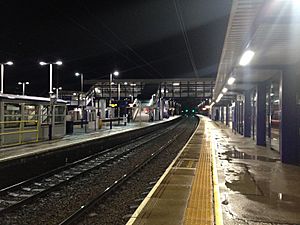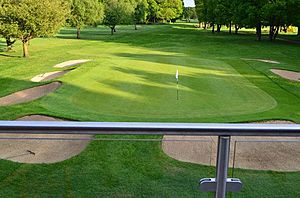Harpenden facts for kids
Quick facts for kids Harpenden |
|
|---|---|
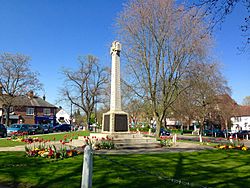 Church Green in Harpenden town centre in spring |
|
| Area | 4.93 sq mi (12.8 km2) |
| Population | 29,448 (2011: parish) 30,240 (2011: built-up area) |
| • Density | 5,973/sq mi (2,306/km2) |
| OS grid reference | TL135145 |
| Civil parish |
|
| District | |
| Shire county | |
| Region | |
| Country | England |
| Sovereign state | United Kingdom |
| Post town | HARPENDEN |
| Postcode district | AL5 |
| Dialling code | 01582 |
| Police | Hertfordshire |
| Fire | Hertfordshire |
| Ambulance | East of England |
| EU Parliament | East of England |
| UK Parliament |
|
| Arms of Harpenden Town Council | |
|---|---|
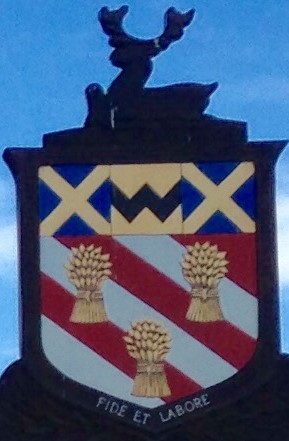 |
|
| Crest | On a Wreath of the Colours within Wattled Palings proper a Mount Vert thereon a Hart lodged also proper |
| Blazon | Bendy of six Gules and Argent three Garbs Or a Chief Azure thereon a Pale between two Saltires throughout of the third a Fess dancetté Sable |
| Motto | Fide Et Laborare (By Faith And Industry) |
| Granted 4 February 1949 | |
Harpenden is a town and civil parish in the City and District of St Albans in the county of Hertfordshire, England. The population of the built-up area was 30,240 in the 2011 census, whilst the population of the civil parish was 29,448. Harpenden is a commuter town, with a direct rail connection through Central London and property prices well over triple the national average.
Contents
History
There is evidence of pre-Roman Belgic farmers in the area. In 1867 several items were found including a bronze escutcheon, rams-head shaped mounts, and a bronze bowl.
There are Roman remains in land around Harpenden, for instance the site of a mausoleum in the park at Rothamsted. A tumulus near the river Lea was opened in the 1820s and it contained a stone sarcophagus of Romano-Celtic origin. Five objects dating from around 150 AD, were inside including a glass jug with a Mediterranean stamp and samian ware dishes used for libations.
Up to the 13th century the area of the parish consisted of woodland with small hamlets and single farmsteads around cleared areas called "End" or "Green" and there are 19 Ends and 18 Greens in area of Harpenden and Wheathampstead parishes. Many of these still survive today.
Harpenden village grew out of Westminster Abbey's gradual clearing of woodland for farming and settlement within its Wheathampstead manor, granted by Edward the Confessor in 1060. A first reference to a parish church is in 1221 (where it is referred to as Harpendene) so it is inferred that the village grew up around then. The church of St Nicholas is the oldest church in the town, originally built as a Chapel of ease in 1217.
Just beyond the southern edge of the town lies Nomansland Common (sometimes simply called "No Man's Land") upon which part of the Second Battle of St Albans was fought during the Wars of the Roses. Nomansland Common also saw the first annually contested steeplechase in England, in 1830 when it was organised by Thomas Coleman, and the last fight of nineteenth century bare-knuckle fighter, Simon Byrne. It was also the haunt of the highwaywoman Lady Katherine Ferrers, better known as the "Wicked Lady".
A widespread but now little-known industry of Harpenden was straw-weaving, a trade mainly carried out by women in the nineteenth century. A good straw weaver could make as much as a field labourer. The straw plaits were taken to the specialist markets in St Albans or Luton and bought by dealers to be converted into straw items such as boaters and other hats or bonnets.
The arrival of the railway system from 1860 and the sale of farms for residential development after 1880 radically changed Harpenden's surroundings. First the Dunstable Branch of the Great Northern Railway passed through the Batford area with a station later named Harpenden East railway station (this line is now closed and forms a cycle track). Then the main line of Midland Railway was built in 1868 with a station near the main village which still exists today. The Harpenden and Hemel Hempstead Railway, know locally as the Nicky Line was opened in 1877.
Between 1848 and 1914 the common was a regular venue for horse racing. In his History of Hertfordshire in 1879, John Edwin Cussans commented "Notwithstanding that these meetings are under the most unexceptional patronage as regards the Stewards, yet for two days in the year all the London pickpockets, sharpers and blackguards who happen to be out of gaol are permitted to make Harpenden their own and to make travelling in a first-class carriage on the Midland Railway a danger to men and an impossibility to ladies." Golf has been played on the Common since 1894 and it was at that time Harpenden Golf Club was set up by a group of Harpenden people with the help and a financial contribution of 5 pounds from Sir John Bennet Lawes of Rothamsted Manor. The club moved to a new course at Hammonds End in 1931, at which time Harpenden Common Golf Club was formed by those who wanted to remain at the Common. In 1932 Bamville Cricket club was formed and shares part of the Common with the Golfers.
Harpenden is the home of Rothamsted Manor and Rothamsted Research (formerly Rothamsted Experimental Station and later the Institute of Arable Crops Research), a leading centre for agricultural research. In front of its main building, which faces the common, is a stone, erected in 1893, commemorating 50 years of experiments by Sir John Bennet Lawes and Joseph Henry Gilbert..
Lawes inherited the family estate at Rothamsted in 1834. Acknowledged as "the father of agricultural science", his early field experiments on Hertfordshire farms led him to patent a phosphate fertiliser, the sales of which enriched him immensely. With the proceeds, he established the experimental station, building laboratories in the 1850s. The station continued the development of the artificial fertilisers on which most modern farmers now depend. Some of the long-term 'classical field experiments' begun by Lawes and Gilbert remain in place to this day (such as Broadbalk) representing a unique resource for agricultural and environmental research.
In 1913 the National Children’s Home moved to Harpenden with a large site Highfield Oval which was home to over 200 children. The site featured a print works, a carpenters’ and joiners’ shop, a bootmakers shop and a farm where boys undertook apprenticeships. Girls were mainly trained in domestic service with some being trained in sewing and office work. The children lived in a "family" of 8-10 children each run by a sister or house mother. The chapel was gift from Joseph Rank and was built in 1928. The home was run on site until 1985. The site is now the head office of Youth with a Mission an international Christian missionary organization. The Harpenden Growth Study, one of the earliest longitudinal tests, was overseen by James Mourilyan Tanner and monitored the development of many of the children over a number of years.
During the Second World War, Harpenden was used to evacuate children from heavily-bombed London. However, Harpenden was not totally confident in its safety, as evidenced by the now decaying Bowers Parade air raid shelters, soon to be secured for the future. It has been suggested both that it be used for educational and emergency training purposes.
The Harpenden and District Local History Society has a collection of local material and archives which can be consulted, and holds regular meetings on topics of historical interest.
Geography
There are two civil parishes: Harpenden and Harpenden Rural.
As Harpenden is located in Hertfordshire just outside London, Harpenden is an area of extremely high property costs. This is common in the region. Land Registry data suggests that the average house price in Harpenden in the 1st quarter of 2006 was £500,902 (against £287,277 for St Albans District generally, and £183,598 nationally). The data also indicates that an unusually high proportion of houses in Harpenden are owner occupied (81.4%, as opposed to 69.6% in the District generally, and 66.2% nationally). The average price of a detached house is over £900,000 as of January 2012.
Harpenden has a large number of its streets named after English literary figures on the East side of the town (an area known, unsurprisingly, as the Poets' Corner), including Byron Road, Cowper Road, Kipling Way, Milton Road, Shakespeare Road, Spenser Road, Shelley Court, Tennyson Road, Townsend Road, Masefield Road and Wordsworth Road.
The River Lea flows through the Batford neighbourhood.
Transport
Harpenden railway station is served by Thameslink services on a frequent and fast rail link through central London. Suburban services stop at all stations on the route, while express services stop at St Albans City before continuing non-stop to London St Pancras. Trains run north to Luton and on to Bedford. From London St Pancras, trains continue south through major London interchanges, such as Farringdon and London Blackfriars, before continuing on to Brighton via Gatwick Airport, Sevenoaks or Wimbledon and Sutton. The rail link therefore gives direct access to Luton Airport (one stop north) and Gatwick Airport, taking approximately 1hr 10 m on a limited stops train.
The standard off-peak services are as follows:
| Route | Times | Trains per hour | Operator |
|---|---|---|---|
| Bedford to Brighton | All day | 2 | Thameslink |
| Bedford to Gatwick Airport | All day | 2 | Thameslink |
| Luton to Rainham | All day | 2 | Thameslink |
| Bedford to East Grinstead | Peak only | 2 | Thameslink |
| Bedford to Littlehampton | Peak only | 2 | Thameslink |
| Luton to Orpington | Peak only | 2 | Thameslink |
| Bedford to Three Bridges | 00:01 - 04:00 | 2 | Thameslink |
| Preceding station | Following station | |||
|---|---|---|---|---|
| Luton Airport Parkway | Thameslink | St Albans City | ||
| Disused railways | ||||
|
Roundwood Halt
Line and station closed
|
Midland Railway
Nickey Line
|
Terminus | ||
| Luton Hoo Line and station closed |
Great Northern Railway Dunstable Branch |
Wheathampstead Line and station closed |
||
The Nickey Line railway used to link Harpenden, Redbourn and Hemel Hempstead. It has since been converted to a path forming part of the National Cycle Network.
The A6 used to run through Harpenden, although the road numbering was changed to avoid congestion. The M1 runs nearby. The closest access to the M1 is Junction 9 at Redbourn & Dunstable or alternatively Junction 10 for Luton Airport.
A number of bus services pass through Harpenden. There are four main routes:
| Route Number | Route | Operator | Operation |
|---|---|---|---|
| 321 | Luton station |
Arriva Shires & Essex | Every 20 minutes (Monday - Saturday)
Every 60 minutes (Sunday) |
| 366 | Luton station |
Centrebus | Every 60 minutes (Monday - Friday) |
| 610 | Luton station |
Uno | Every 60 minutes (Monday - Saturday) |
| 657 | Harpenden to St Albans via Wheathampstead (extending to Redbourn on School Days) | Uno | Every 60 minutes (Monday - Saturday) |
A fifth bus service, the Metroline 84A, which served Luton Airport, St Albans and stops to New Barnet, ceased running between Luton Airport and St Albans in April 2017.
Harpenden also has a Charity run Community Bus service called the Harpenden Hopper, which is a hail and ride service operating in various parts of the town; it is currently running 3 days a week (Tues, Weds and Thurs).
http://www.harpendenhopper.co.uk/
Parks and commons
A notable feature of Harpenden is its abundant parks and commons. The central area of Harpenden, known locally as "the village" is characterised by Church Green, Leyton Green and the High Street Greens, which give the town its provincial feel.
Just to the south of the town centre is Harpenden Common, stretching from the shops in the town centre for more than a mile to the south, encompassing a total of 238 acres (96 ha). Today Harpenden Common hosts two cricket clubs, Harpenden Cricket Club, a Hertfordshire Premier League club that celebrated its 150 anniversary in 2013 and Bamville Cricket Club who play on Sundays on the golf course, a football club, bridle ways for horse riding, ramblers' paths and Harpenden Common Golf Club, all contained in an area of natural beauty which was awarded a national Green Flag Award in 2007. Harpenden Town Council is keen to help retain and maintain the environment and oversees habitat issues including bird and bat watching, the maintenance/regeneration of gorse, fungi and all the original wildlife (fauna and flora) for the benefit of the people of Harpenden. Since 1894 Harpenden Common Golf Club has traditionally maintained a large part of the common and today works closely with Harpenden Town Council and Countryside management. This partnership has enabled the people of Harpenden to take full advantage of the common for all kinds of leisure activities, and the relationship of the golfers and others users has been excellent for many years.
In addition the town has large green public spaces available in Rothamsted Park, Batford Park, Kinsbourne Green, Lydekker Park and the Nicky Line which bisects the town.
Just to the south of Harpenden is the large expanse of Nomansland Common.
Twinning
Harpenden is twinned with:
 Cosne-Cours-sur-Loire, France
Cosne-Cours-sur-Loire, France Alzey, Germany
Alzey, Germany
Miscellany
- Harpenden Lions Highland Gathering continues a tradition that began in 1946. The Gathering is held every July in Rothamsted Park and attracts typically 5,000 visitors. It claims to be the largest UK Highland Gathering outside of Scotland. It raises many thousands of pounds each year for charities nominated by Harpenden Lions Club who run the event.
- An annual classic car show, "Classics on the Common", is held on the last Wednesday in July attracting over 10,000 visitors and 1300 cars. One of the biggest events of its type in Europe, it is a free event with any profits collected going to charity.
Gallery
Economy
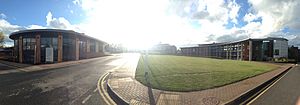
Harpenden is a prosperous town. In an analysis of the average income tax paid by constituency, Hitchin and Harpenden came tenth. In a list of the most valuable commuter areas compiled by Savills Research Harpenden came seventh. Good transport links to central London have been cited as a key factor.
Rothamsted Research, the largest agricultural research centre is based in Harpenden, it was founded in 1843.
Sport
Harpenden is home to various sports clubs. Just a selection are listed below:
- Harpenden Cricket Club
- Harpenden Town Football Club
- Harpenden Rugby Football Club
- Elliswick Lawn Tennis Club
- Harpenden Lawn Tennis Club
- Harpenden Dolphins Cricket Club
- Bamville Cricket Club
- Harpenden Colts Football Club
- Harpenden Hockey Club
- Harpenden Golf Club
- Harpenden Common Golf Club
- Harpenden Swimming Club
- Harpenden (Lawn) Bowling Club
- Harpenden Aro Runners [1]
- Skew Bridge FC [2]
- Harpenden Rovers Football Club
- Harpenden Forastero Cycling
Education
Harpenden has several secondary schools:
- St George's School, a coeducational Christian day and boarding school and specialist Technology, and Language College.
- Sir John Lawes School, a specialist Media Arts College, Science College and Teacher Training college.
- Roundwood Park School, a specialist Mathematics and Computing College and Language College.
- Katherine Warington School, which opened in September 2019.
Harpenden has a number of state primary schools, including:
- Manland Primary School
- Crabtree Infants' and Junior Schools
- Roundwood Primary School
- The Grove Infant & Nursery and Junior Schools
- High Beeches Primary School
- Wood End School
- Sauncey Wood Primary School
- The Lea Primary School & Nursery
- Harpenden Academy
It also has three private schools:
- Aldwickbury School is an independent all-boys preparatory school (years Reception to 8).
- The King's School is an independent Christian school (pre-school age to year 11).
- St Hilda's School is an independent primary school for girls (years Reception to 6).
Notable residents
- Azeem Alam, BEM, doctor and entrepreneur, lives in Harpenden
- Julian Bliss, international clarinettist and child prodigy was born and raised in Harpenden
- Steve Borthwick, former England and Saracens rugby captain lives in Harpenden
- Steve Bould, former professional footballer and current Arsenal assistant manager
- Ken Brown, who played in the Ryder Cup and is now a commentator for major golf competitions, such as the Open, grew up and still lives in Harpenden and is a member of Harpenden Common Golf Club
- Craig Charles, comedian and actor in Red Dwarf and Coronation Street and host of the Funk and Soul Show and Robot Wars lived in Harpenden.
- Ralph Chubb, poet, artist and printer was born here in 1892
- Dave Clarke, visually impaired Paralympic GB football captain.
- George W. Cooke, deputy director of Rothamsted Experimental Station
- Donald Coxeter, 20th century geometer attended St George's School
- Matt Dickinson, Everest mountaineer, author, scriptwriter and director
- Lee Dixon, former Arsenal footballer
- Ferdinand Walsin Esterhazy, a spy for the German Empire, at the heart of the Dreyfus affair, fled from France in 1898 and lived in Milton Road until his death in 1923. He is buried in St Nicholas' churchyard under the false name of Jean de Voilemont.
- Siobhan Fahey, singer in Bananarama lived in Harpenden while she was 14 – 16. She attended Sir John Lawes School for those 2 years
- Andy Farrell, Saracens and England rugby player
- Owen Farrell, Rugby player for Saracens and a former member of St George's School
- Ronald Fisher, a statistician who almost single-handedly created the foundations for modern statistical science. worked at Rothamsted Experimental Station
- Ben Foden, Northampton Saints and England International Rugby Union player
- Miles Golding, classical musician and violinist of Split Enz
- Martin Gore from the band Depeche Mode
- Laura Haddock actress who appeared in Guardians of the Galaxy and other films, went to school in Harpenden
- Mick Harford former England international footballer and manager. Currently working for Luton Town Football Club, whom he has previously managed.
- Una Healy, singer from The Saturdays
- Richard Herring, Comedian and podcaster, living in Harpenden while London home is renovated
- Steve Hewlett, (1958 - 2017), former presenter of The Media Show on BBC Radio 4
- George Hogg, British journalist who rescued 50 orphaned children in China during the Japanese occupation
- Charlie Hutchison, British communist, liberator of Belsen concentration camp, and only black British International Brigades volunteer. Spent several years in an orphanage in Harpenden.
- Frank Ifield, Australian singer and yodeller lived in Harpenden
- Guy Johnston, cello soloist and winner of BBC Young Musician of the Year in 2000
- John Keane, artist, was born here and grew up in Wordsworth Road.
- Stanley Kubrick, filmmaker, lived and died in nearby Childwickbury Manor
- Henry Lawson, Australian writer, lived in 'Spring Villa', Cowper Rd, Harpenden from July–September 1900
- Joe Lenzie Music producer and DJ was born in Harpenden and attended Sir John Lawes School
- Terry Lightfoot, Jazz clarinettist, ran the Three Horseshoes pub for five years during the late 1970s
- Andy Linighan, former Arsenal footballer lived in Bewdley Close, Southdown
- James Mardall (1899–1988), first-class cricketer and British Army officer
- Doug McAvoy, former General Secretary of the National Union of Teachers lived in Harpenden between 1975 - 1990
- Joan Moore, botanist (1920–1986)
- Eric Morecambe, comedian, lived in Harpenden, close to his beloved Luton Town FC. His funeral and burial took place in St Nicholas Church. The Public Halls are named after him
- Albert Moses, an actor who starred in Mind Your Language playing Punjabi student Ranjeet Singh and a number of James Bond films
- John Motson, Football commentator
- Tim Rice, the composer, attended Aldwickbury School
- David Richardson, music producer, audio engineer, musician and founder of Sound Recording Technology, was born and lives in Harpenden
- David Roberts (born 1942), cricketer
- David Sharp (mountaineer), mountaineer who died near the summit of Mount Everest
- Tim Sherwood, former Tottenham Hotspur and Blackburn Rovers player who lived in Harpenden during his coaching days at Tottenham
- Christopher Smith (MP) (d. 1589), owner of Annables Manor in Harpenden.
- Sir Robert Stephen John Sparks CBE FRS, eminent volcanologist, was born in Harpenden. His former PhD student Prof Claire Horwell also grew up in Harpenden.
- Christopher Strauli, actor, who starred in Only When I Laugh and Full House was born in Harpenden
- Dame Ellen Terry, actress 1847–1928, who lived in Harpenden from 1868 to 1874
- Katherine Warington, research botanist, 1897–1993, born and lived in Harpenden; worked at Rothamsted Experimental Station
- Jack Wilshere West Ham and England international footballer
- Sir John Wittewronge, owned and lived at Rothamsted Manor, where in the seventeenth century he kept a weather and gardening diary which has very early records of rain, temperature and winds
- Ashley Young, former Manchester United and England international footballer
- Richard Youngs alternative musician, grew up in the town and recorded several albums there, especially Lake and Advent
Images for kids
See also
 In Spanish: Harpenden para niños
In Spanish: Harpenden para niños



